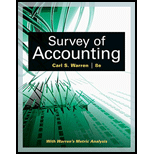
Concept explainers
Concept Introduction:
Financial statements:
Financial statements are prepared to summaries the account at the end of the period. The statements prepared are Income statement,
Balance Sheet:
The Balance sheet is a summary of Assets, Liabilities and equity accounts that reports the financial position of the business as on a specific date. Assets are further classifies into Current Assets, Long Term Investments, Plant Assets and Intangible assets. And Liabilities are further classified into Current Liabilities and Long term liabilities.
Basic Earnings per share:
The Basic Earnings per share is the amount of net income earned by each common share outstanding. The Earnings per share calculated by with help of following formula:
To Indicate:
The effect of purchase of
Want to see the full answer?
Check out a sample textbook solution
Chapter 8 Solutions
Survey of Accounting (Accounting I)
- HELParrow_forwardFrazer Corporation owns 70 percent of Messer Company's stock. In the 20X9 consolidated income statement, the noncontrolling interest was assigned $18,000 of income. There was no differential in the acquisition. Required: What amount of net income did Messer Company report for 20X9?arrow_forwardAnsarrow_forward
- Could you help me solve this financial accounting question using appropriate calculation techniques?arrow_forwardWhat is the cost per equivalent unit for direct materials for Marcharrow_forwardCan you help me solve this general accounting question using the correct accounting procedures?arrow_forward
- A company carries an average annualinventory of $8.3 million if it estimates the cost of capital is 11% so much costs are 7% and risk calls are 12%. What does it cost per year to carry this inventory?arrow_forwardWhat did granvia report for cash from financial activities ?arrow_forwardAnswer me pleasearrow_forward
 Survey of Accounting (Accounting I)AccountingISBN:9781305961883Author:Carl WarrenPublisher:Cengage Learning
Survey of Accounting (Accounting I)AccountingISBN:9781305961883Author:Carl WarrenPublisher:Cengage Learning College Accounting, Chapters 1-27 (New in Account...AccountingISBN:9781305666160Author:James A. Heintz, Robert W. ParryPublisher:Cengage Learning
College Accounting, Chapters 1-27 (New in Account...AccountingISBN:9781305666160Author:James A. Heintz, Robert W. ParryPublisher:Cengage Learning Managerial AccountingAccountingISBN:9781337912020Author:Carl Warren, Ph.d. Cma William B. TaylerPublisher:South-Western College Pub
Managerial AccountingAccountingISBN:9781337912020Author:Carl Warren, Ph.d. Cma William B. TaylerPublisher:South-Western College Pub Financial And Managerial AccountingAccountingISBN:9781337902663Author:WARREN, Carl S.Publisher:Cengage Learning,
Financial And Managerial AccountingAccountingISBN:9781337902663Author:WARREN, Carl S.Publisher:Cengage Learning, Managerial Accounting: The Cornerstone of Busines...AccountingISBN:9781337115773Author:Maryanne M. Mowen, Don R. Hansen, Dan L. HeitgerPublisher:Cengage Learning
Managerial Accounting: The Cornerstone of Busines...AccountingISBN:9781337115773Author:Maryanne M. Mowen, Don R. Hansen, Dan L. HeitgerPublisher:Cengage Learning College Accounting, Chapters 1-27AccountingISBN:9781337794756Author:HEINTZ, James A.Publisher:Cengage Learning,
College Accounting, Chapters 1-27AccountingISBN:9781337794756Author:HEINTZ, James A.Publisher:Cengage Learning,





